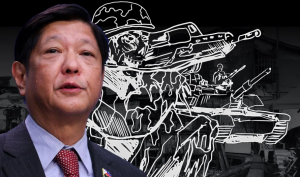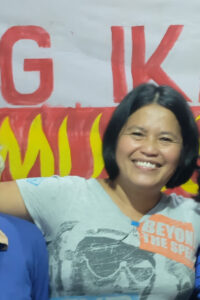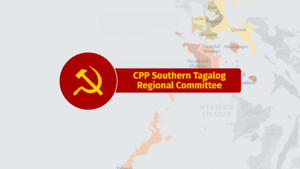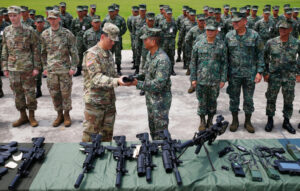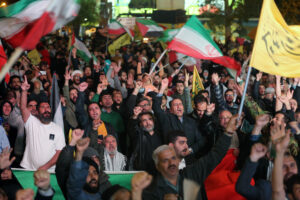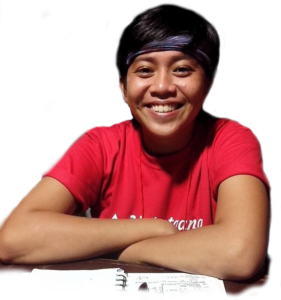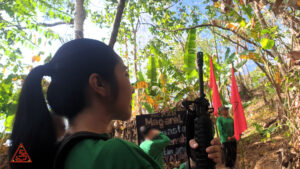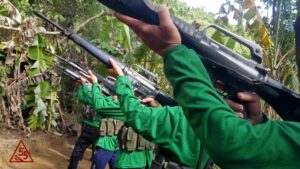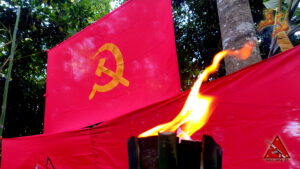Keynote Speech by Jose Maria Sison at Tanggol Kasaysayan Conference: Martial Law@50 Debunking Lies and Distortions about Martial Law under Marcos
Dear Compatriots and Friends,
First of all, I wish to thank Profs. Francis Gealogo and Laurence Wilson S. Castillo of Tanggol Kasaysayan for inviting me to serve as keynote speaker in this conference billed as Tanggol Kasaysayan ng Martial Law @50, a conference of progressive academics, activists and mass leaders.
It is highly commendable that Tanggol Kasaysayan is sponsoring this conference and will publish a book containing the speeches and papers in this conference. The publication of the book is an excellent way of marking the 50th anniversary of the Marcos fascist dictatorship, refreshing and reinvigorating the collective memory of the Filipino people about it and inspiring them to fight all attempts to revive and perpetuate such an evil rule of terror and greed.
We must uphold, defend and propagate the historical facts about the background, circumstances and consequences of Proclamation No.1081 dated September 21, 1972 and issued by Ferdinand E. Marcos. This was mainly and essentially intended to impose a fascist dictatorship on the Filipino people and enable Marcos to violate their national and democratic rights and interests, commit gross and systematic human rights violations and plunder the national treasury, social wealth and natural resources of the country.
We must stand up, tell the truth and condemn the lies and distortions being spread by the propaganda machinery of the Marcos political dynasty, the incumbent president Duterte and their allies through the state and corporate mass media, the social media and the bill boards, streamers and other paraphernalia of propaganda at street level.
The single message being delivered is that the brutal and corrupt regime of Marcos the father was a golden era for the Philippines and that the people must in an act of gratitude elect the junior as president. Bongbong is in tandem with Sara, the daughter of the incumbent fascist tyrant Rodrigo Roa Duterte. The Marcos-Duterte tandem represents the most brutal and corrupt political dynasties that have ruled the Philippines.
The Marcos political dynasty is now using huge amounts of money for propaganda and buying the support of reactionary officials and groups at various levels. Only a small part of the Marcos bureaucrat loot, conservatively estimated at USD 10 billion has been recovered by the post-Marcos regimes. Even then, the Presidential Commission on Good Government (PCGG), initially created by the Cory Aquino to investigate and recover what Marcos had stolen, has the biggest collection of evidence against Marcos and his family in this regard.
The PCGG has recovered assets valued at USD 3.6 billion or about one-third of the greatly understated ill-gotten wealth of the Marcoses in the Philippines and abroad, despite such obstacles as multi-layered corporate methods of concealment, protraction of legal and judicial processes, the noncooperation of foreign governments and corporations complicit with Marcos and the internal weaknesses of the PCGG. Thus, most of the ill-gotten wealth of the Marcoses are being used by them to keep the life style of billionaires, to secure their provincial political base and to reclaim political power at the national level for the purpose of further butchery and plunder.
At present, it is most convenient for Marcos Jr. to team up with Sara Duterte because her father Rodrigo is in a position to rig the 2022 presidential elections because of his control over the military and bureaucracy, especially the Comelec. The Marcos-Duterte tandem and its slate of senatorial and local candidates go through the motion of campaigning even as they are self-confident about “winning” through electoral fraud and terrorism.
But still it is necessary for the Filipino people and all their patriotic and democratic forces to debunk the lies and distortions of the Marcos-Duterte campaign and to engage in the arousal, organization and mobilization of the masses and to demonstrate who are the real winners in the elections and prepare for gigantic mass actions similar to those that felled the Marcos fascist dictatorship in 1986 within the framework of protracted struggle for national and social liberation.
Let us now proceed to expose the major lies and distortions being made about the Marcos fascist dictatorship to deceive and mislead the people. We present the historical facts about political, socio-economic, cultural and foreign policy issues pertinent to the Marcos fascist dictatorship.
Political Issues
To become a congressman of Ilocos Norte after World War II, Ferdinand Marcos relied on his reputation as bar topnotcher, oratorical skills and pro-poor populist rhetoric but he depended mainly on the captive votes of the tenants of landlord families, like my relatives ramifying from the Valdez-Serrano family of San Nicolas, Ilocos Norte. As congressman, he set his mind on becoming a big bureaucrat capitalist and no less the president of the Philippines.
He got his share of pork barrel from contractors of graft-laden public works but he got his largest loot from facilitating Chinese immigration and naturalization and then from foreign exchange allocations of Central Bank to Chinese businessmen through their Filipino dummies. The amount of bureaucratic loot that Marcos made allowed him to purchase his San Juan residence, build a mansion in Batac, Ilocos Norte and, according to Imelda, keep sacks of cash for patronage and other political purposes.
It is not true that before becoming a politician he was already wealthy by inheritance from his parents, from his practice of law, from the Yamashita hoard and from the blatantly mythical “Tallano gold.” Mariano Marcos, the father of Marcos, was of rich peasant origin and the Edralin mother had a father who was a small landlord who had been the administrator of church land before the Philippine revolution of 1896.
Marcos was nowhere near the so-called Yamashita hoard in the mountain provinces during the anti-Japanese offensive in 1944-45 because he was regarded as a traitor by the USAFFE guerrillas and his own father was a notorious pro-Japanese collaborator who had been recently executed by the guerrillas as a traitor. The false history about the Philippines being known before as Maharlika and ruled by the Tallano family which ultimately through the ages delivered gold to Marcos in a quantity beyond the mining done by the whole world is a fairy tale contrived by Marcos.
When he rose to the Senate presidency, he had bigger opportunities for graft and corruption and used them. He challenged the leadership of the incumbent president Macapagal within the Liberal Party and eventually he joined the Nacionalista Party through the sponsorship of Jose P. Laurel who had become his patron since the latter as justice of the Supreme Court had maneuvered to overturn the criminal conviction of Marcos for the murder of Rep. Julio Nalundasan of the second district of Ilocos Norte in 1935.
He ran for the presidency in 1965 against Macapagal. By then, the latter had become thoroughly discredited by the national democratic movement for his pro-imperialist and reactionary policies and actions. Marcos cleverly hired Blas Ople and the like to campaign for him with the use of bourgeois nationalist slogans. He himself kept on babbling about “making this nation great again” and he misrepresented himself with fake medals as war hero against the Japanese occupation.
Indeed, as USAFFE junior officer, he was in Bataan and became interned in the Tarlac concentration camp. But after the puppet president Jose Laurel caused his release from the camp, Marcos focused on business deals with the Japanese invaders in line with his own father’s notorious role as chief propaganda officer of the Japanese fascists. Only after the war did Marcos invent his Maharlika guerrilla regiment and his medals of valor. But the US authorities uncovered his false claims for war back pay as well as for war damage payments for imaginary ranches of the Marcos family in Davao.
When he became president in 1965, he became his own defense secretary for 13 months before appointing Ernesto Mata. He made sure that military officers from Ilocos Norte would be dominant in the reactionary armed forces, He started to hype the need for increasing the number and firepower of the military. At the same time, he planned to use infrastructure projects on a grand scale to impress the public and to accumulate his cuts from the contracts. He rapidly exhausted the Japanese war reparations.
A major part of his loot from the Japanese-funded projects was deposited in Credit Suisse in several accounts under the names of paper foundations. The cash deposits grew from an initial deposit of around USD 100 million to more than USD 800 million and would be exposed after the fall of Marcos and became subject to claims by the Philippine government and by the victims of human rights violations who had won the human rights case against the Marcos estate in the 1990s under the US judicial system.
After the exhaustion of the Japanese war reparations, Marcos would use foreign loans from the World Bank and the Asian Development Bank for his infrastructure projects and his private accumulation of bureaucratic loot. He shunned genuine land reform and national industrialization and favored pork barrel economics and corruption. He also kept on raising the budget for the military and received US CIA funds for deploying the Philippine Civic Action Group to Vietnam as part of the US war of aggression.
In his second term as president from 1969 onward, Marcos raised the volume of his propaganda that the Philippines was a “social volcano about to explode” and he clamored for more appropriations for the military and for more grants and credit sales of military equipment as rent from the US in for the use of the military bases in the Philippines. He readily agreed with Nixon when he issued his so-called Asian doctrine that Asian countries must take care of their own national security with US military and economic support against the “communist threat.”
In the meantime, the Communist Party of the Philippines had just been reestablished itself on December 26 1968 and founded the New People’s Army on March 29, 1969. The Moro people also became restive and assertive of their right to national determination. Marcos exaggerated the strength of the CPP and NPA and the Moro National Liberation Front (MNLF) even while they were still small and weak.
In 1971, he and his military minions carried out the Plaza Miranda grenade attack against the Liberal Party and other false flag operations, using explosives, to give him the pretext for immediately suspending the writ of habeas corpus and preparing for the declaration of martial law in 1972 and imposition of fascist dictatorship on the Filipino people. In 1972 He repeated the bomb explosions at public places in order to set the stage directly for the proclamation of martial law.
In his proclamation, he declared that he was out “to save the republic” and “build a new society” and he made the brazen lie that the NPA had 10,000 rifles. At that time, the NPA had only some 300 rifles in Isabela and a few other regions. By imposing martial law on the entire nation, Marcos was able to concentrate the powers of government in his hands as he padlocked Congress and intimidated the Supreme Court to declare his martial rule nonjusticiable.
He closed all mass media, except those of the government and those he confiscated and placed under the ownership of his crony Roberto Benedicto and other dummies. He ordered the mass arrest of opposition leaders, constitutional convention delegates, leaders and members of patriotic and democratic mass organizations and social critics. He hijacked the ongoing constitutional convention and forced changes in the draft constitution to turn it into a fascist constitution. He brazenly described his fascist dictatorship as “constitutional authoritarianism”.
He committed gross and systematic human rights violations in order to suppress any manifestation of criticism or opposition to his fascist dictatorship from 1972 to 1986. The conservative estimates of these made by Amnesty International and the Task Force Detainees include at least 70,000 arbitrarily detained, undetermined number of “disappeared”, 35,000 documented torture and 3,257 known extrajudicial killings cum torture and mutilation. These were reported and documented in the human rights case filed in the US against the Marcos estate.
According to the International Committee of the Red Cross, millions of people were displaced internally and some three million of Moros sought refuge in Sabah. The worst and most numerous human rights violations were committed in the rural areas and urban poor communities by the fascist military, police and paramilitary. Here the victims were not recorded fully by human rights organizations because of their limited personnel and means, especially during the years of fascist dictatorship.
The rigors and brutality of the Marcos fascist dictatorship failed to suppress the revolutionary movement of the people. Instead, this became stronger by leaps and bounds nationwide because the patriotic and democratic mass organizations went underground and formed the National Democratic Front in order to fight the regime of terror and greed. At the same time, many of the people who could not leave their children and families had to stay aboveground and take high risks in the legal struggle.
From 1979 onwards, the fascist regime was thoroughly discredited by its own brutality and corruption. International credit began to tighten. US President Carter told Marcos to lift martial law. Thus Marcos pretended to lift it 1981. By then, new patriotic and democratic mass organizations had arisen aboveground to take the place of those organization that went underground in 1972.
By 1982, inflation was running high amidst high unemployment and mass poverty. Marcos made his biggest political mistake by having his arch political rival Benigno Aquino assassinated in 1983. This resulted in the upsurge of mass protests which resulted in the gigantic mass actions in the national capital region and nationwide that toppled the Marcos fascist dictatorship after it cheated in the 1986 snap presidential elections.
The Marcos dictatorship was isolated and defeated by a combination of developments, such as the rapid advance of the armed revolutionary movement of the people, the resurgence of patriotic and democratic forces in the urban areas and the junking of Marcos by the US, the Catholic Church and other religious organizations, the Makati Business Club and the conservative opposition who were outraged by the murder of Aquino and feared the further rise of the revolutionary movement if Marcos remained in power any longer.
Economic and Social Issues
Despite some limited amount of rhetoric for economic nationalism to oppose Macapagal’s blatantly pro-imperialist “free enterprise” ideology and open door policy to foreign investments during the 1965 electoral campaign, Marcos proceeded to adopt and implement an economic policy subservient to foreign monopoly capitalism and the local exploiting classes of big compradors and landlords. He perpetuated and aggravated the semicolonial and semifeudal ruling system which he as bureaucrat capitalist could prosper together with the big compradors and landlords.
Marcos was determined to enrich himself by overspending on and overpricing infrastructure projects in order to collect huge amounts of commissions, brokers’ fees and other forms of bribe from the foreign firms preparing feasibility studies, foreign suppliers of construction equipment and materials and a hierarchy of local contractors headed by cronies. At the same, he gained prestige from building the roads and bridges even as these were merely for facilitating the extraction of mineral ores, logs and other natural resources and the distribution of finished manufactures from abroad.
It is true that Marcos was responsible for the construction of 1,201 km new asphalt roads; 2,124 km of gravel roads; 15,831 lineal meters of bridges; 38,705 permanent school buildings and 58,745 prefabricated school buildings. But these were funded by onerous foreign loans and were extremely overpriced to allow for huge bribes for Marcos and his cronies. Many of these infrastructure projects were substandard and would eventually become decrepit.
Financial resources were deliberately taken away from the direction of genuine land reform and national industrialization. The industry sector continued to be described as import-substitution and heavily dependent on imported equipment and components. The economy remained agrarian, pre-industrial and semifeudal, with more than 65 per cent of the population devoted to agriculture. But Marcos tried to misrepresent as factors of industrialization certain crony companies involved in the infrastructure projects and in the supply of reshaped steel products, cement, gravel and the like.
The overspending on infrastructure projects, the bureaucratic corruption and annual increases of the military budget would eventually cause huge budgetary and trade deficits, resulting in a mounting debt burden and huge debt service payments. The technocrats of Marcos were aware of the unsustainability of the huge deficit spending and foreign loans. And they pushed the Omnibus Tax Law of 1969 in order to collect taxes from real estate owners and landlords to augment revenues from excise taxes and foreign loans.
The Marcos regime spent colossal amounts of financial resources not only on roads, highways and school buildings but also on the Bataan nuclear power plant and high-profile health and cultural edifices. But always the vile purpose of Marcos was to overprice the public construction and take his bribes at various levels of each contract. It is well known that contrary to the traditional practice of presidents exacting 20 per cent of every project Marcos exacted 80 per cent of project cost because of the extreme overpricing.
Let us focus on the notorious case of the $2-billion Bataan Nuclear Power Plant, which has never been operated because it sits on a major geologic fault line. Total repayments amounted to $22 billion up to 2007. The annual debt service was $140 million. A crony claimed that Marcos received an $80-million payoff. But this is too small and unbelievable. In fact, Herminio Disini the main crony of Marcos in the project was able to put up a bank in Austria and manage a number of investment accounts for the Marcos family. Disini is one of the loyal Marcos cronies who is managing some of the ill-gotten assets of the Marcos family which are stashed away abroad.
Starting as early as 1977, international credit tightened and the Marcos regime had to beg for debt restructuring from the IMF, prompting the latter to impose tighter credit restrictions and compel the Philippines to shift from import-substitution to export-oriented manufacturing or semi-manufacturing, which involved minor processing of imported components in the garments and semi-conductors. By 1983 foreign loans had comprised 91 percent of GNP and 509 percent of export earnings. The loans also became costlier as creditors imposed higher and floating interest rates.
At the beginning of the Marcos regime in 1965, the foreign debt was only USD 600 million. At the end in 1986, this had risen to USD 28.3 billion or a big leap by 4300 per cent. At first, the overspending artificially pushed up the economic growth rate to as high as 9 per cent in 1973 and 1976. But in the later years of the fascist dictatorship the Philippine economy became depressed, contracting by 7.3 per cent in 1984 and 1985, presaging the downfall of Marcos in 1986. Ultimately, his excessive deficit spending and overdependence on foreign loans caused his downfall..
The Philippines used to be rated as the second largest economy in Asia, behind only Japan, from the 1950 to 1964 when the other Asian countries were still recovering from World War II. It was during the rule of Marcos that the Philippine economy became the basket case of Asia, below South Korea, Malaysia, Thailand, Indonesia, and Singapore, especially during the martial law years of 1972 to 1986. Marcos accepted the dictat from the US that the Philippines would remain a supplier of raw materials to Japan and the other neighboring countries.
In his first term, Marcos pretended to be for developing Philippine agriculture by promoting the so-called miracle rice variety earlier cultured by the International Rice Research Institute. This required high amounts of water from irrigation dams and high amounts of agricultural chemicals, preferably by plantations with some amount of mechanization. Marcos and his cronies had an eye on getting cuts from the irrigation dam projects and monopolizing the local trade of seeds and pesticides under the brand of Masagana 99, which bankrupted the peasant masses.
The cost of rice production became so high that by the time Marcos pretended to be for land reform with Presidential Decree No. 27 in 1972 after the proclamation of martial law the intended land reform beneficiaries could no longer afford the instalment plan for amortizing payment for the land. Furthermore, the landlords and the bureaucrats connived to raise the land price at the expense of the tenants by falsifying the previous annual production figures.
The sugar industry used to be the main foreign exchange earner in the export of agricultural crops. But it was sabotaged by Marcos and his cronies exactly when world sugar prices were rising and they monopolized the warehousing of sugar supposedly to wait for still higher prices. The world demand and prices for sugar suddenly dropped. But still Marcos and his cronies benefited from the disaster by taking over the land of the bankrupted sugar landlords and by privatizing and owning the traditional bank of the sugar industry, the Philippine National Bank.
Under the guise of rejuvenating the coconut industry, Marcos pushed the cutting down of the old coconut trees and the planting of a new breed of shorter coconut trees. He imposed the coconut levy tax supposedly to aid the coconut farmers. But in fact the tax collected has been used to establish the United Coconut Planters Bank (Cocobank) and to finance the land acquisitions, takeover of the San Miguel Brewery Corp. and other business enterprises of the Marcos dummy Eduardo Cojuangco.
Marcos appointed technocrats from the ranks of academics in order to impress the people that he was using honest and competent people but he used them mainly to produce glossy plans and glittering generalities. He relied on his initial cronies, such as Roberto Benedicto who was put in charge of the Philippine National Bank and the sugar industry, Eduardo Cojuangco the Cocobank and the coconut industry and Rodolfo Cuenca in the Construction and Development Corporation of the Philippines. In due course, especially during the fascist dictatorship, the number of cronies
expanded and they controlled all major enterprises in the Philippines.
In getting himself reelected as president in 1969, Marcos spent a huge amount of public money for buying local political supporters and votes from the general public. Thus, he generated inflation and stirred up social unrest. The balance of payments crisis of 1969-70 further stirred up the social unrest. The First Quarter Storm of 1970 broke out, signifying not only the upsurge of the legal patriotic and democratic forces but also the reemergence of the revolutionary forces in the countryside and the urban underground.
Instead of offering substantial social, economic and political reforms along the line of national independence and democracy, Marcos chose to use the social unrest as pretext of declaring nationwide martial law and imposing fascist dictatorship on the people under such bombastic slogans of “saving the republic” and building a new society”. He tested the waters by having his agents throw grenades at the Liberal Party meeting at Plaza Miranda on August 21, 1971, instantly accused the Communist Party of the Philippines of being responsible for the crime and proclaimed the suspension of the writ of habeas corpus.
The Plaza Miranda grenade-throwing was followed by 20 bombings at public places in Manila., This caused significant property damage and some forty casualties in one instance. One bomber was arrested. He turned out to be a bomb expert belonging to the Marcos regime and specifically to the Philippine Constabulary. Senator Benigno Aquino exposed Oplan Double Strike as the Marcos’ scheme of bombings to attack the opposition party and blame communist guerillas for the attacks, and to justify the declaration of martial law in September 1972.
The fascist dictator was satisfied that he was able to obtain absolute power to use the reactionary armed forces and police as he wished, suppress any kind of opposition and plunder the national treasury and social wealth without limits. Under martial law, Marcos had extraordinary legislative as well as executive powers. He was able to extort and confiscate for himself and his cronies a wide range of privately-owned public utilities, such as Meralco, PLDT, three Philippine airline services and mass media corporations, including 7 television stations, 16 national daily newspapers, 11 weekly magazines, 66 community newspapers, and 292 radio stations.
He expanded his use of cronies and established monopolies under their control on his behalf. He used his presidential decrees and letters of instruction to enable his defense secretary Juan Ponce Enrile to control the logging industry, Eduardo Cojuangco to control the coconut industry, Roberto Benedicto the sugar industry, Antonio Floirendo to control the banana industry, and so on. In a semifeudal economy, control of vast agricultural lands to plant export crops is directly connected with the export-import and financial roles of the comprador big bourgeoisie.
The economic and social crisis continued to worsen under the Marcos fascist dictatorship. The oil crisis hit the Philippines in 1973 but the petrodollars flooded the international capital markets from 1975 onwards. However, what appeared to be a boon to the Marcos fascist dictatorship turned out be a lethal bane. It was emboldened to take bigger foreign loans at an accelerated rate. Philippine foreign debt was at USD $4.1 billion in 1975 and doubled to US $8.2 billion in 1977. Then it zoomed to USD 28.3 billion despite the second oil crisis of 1979 and tightening of international credit.
The main cause of the economic nosedive of the Marcos fascist dictatorship was the aggravation of the semicolonial and semifeudal extractive economy and the overdependence on foreign loans to cover the chronic budgetary and trade deficits. When the nose dive began in 1979, the bureaucrat capitalist Marcos and his cronies also unwittingly committed political suicide by rapidly stashing away a major part of their ill-gotten wealth by depositing it in foreign bank accounts, buying shares of stocks in foreign companies and buying property assets (land, buildings, jewelry and art works) under the names of paper corporations and foundations abroad.
Cultural and Educational Issues
The first presidential term of Marcos from 1965 to 1969 coincided with the great upsurge of the national democratic movement among the youth led by the Kabataang Makabayan and the national student organizations. They were consciously striving to continue the unfinished revolution of the Katipunan and the Filipino people and carrying out the Second Propaganda Movement or a cultural revolution demanding a national, scientific and mass educational and cultural system and casting away colonial, feudal and elitist mentality.
The demand for a national culture and education was a demand for patriotism and national liberation against US domination and colonial mentality, for promoting the national language and national cultural heritage and for serving the national rights and interests of the Filipino people. The demand for a scientific culture and education was a demand for expanding the public educational system to counter the dominance of private schools run by religious and commercial interests and to propagate science and technology for national industrial and agricultural development. And the demand for a mass culture and education was a demand for serving the democratic rights nd interests of the masses of workers and peasants.
Marcos chose to be most concerned about the mass demonstrations of the youth in 1965 and 1966 against the unequal treaties, agreements and arrangements with the US and the participation of the Philippine reactionary government and military in the US war of aggression against Vietnam. Thus, he invited the National Council of the Movement for the Advancement of Nationalism (MAN) to seek the slowing down the mass protests as a form support and cooperation. But Senator Lorenzo M. Tanada, MAN chairman, stood his ground and told Marcos that he ought to welcome and encourage the mass actions inasmuch as they support nationalist and democratic policies and actions.
Marcos did not heed the advice of MAN and its chairman. He was a dyed-in the wool puppet of US imperialism even if to some extent he posed as having some sense of patriotism by having the lease of military bases to the US reduced from 99 years to 25 years under the US-RP Military Bases Agreement. But he was merely leveraging his demand for more military grants and credit sales from the US to support his program of beefing up the reactionary armed forces. And he readily agreed with the US to join the US war of aggression against Vietnam in 1966.
In the entire decade of the 1960s, many of the faculty members and students of the University of the Philippines and in other universities were already adopting the Tagalog-based national language as the medium of instruction as a result of the growing strength of the national democratic movement. But the Marcos regime emboldened the UP president Carlos P. Romulo to maintain English as the medium of instruction and worst of all to counter the national democratic movement by tinkering with and further Americanizing the curricula of the university.
Romulo’s tinkering with the curricula in the US involved among others reducing and downgrading of such subjects as Philippine history, the national language and Philippine studies and textbooks written by patriotic Filipinos. For the purpose, he drew funds from the World Bank, Asian Development Bank, the US Agency for International Development and the American foundations, like Rockefeller and Ford. He gained a wider of scope of authority when Marcos appointed him as secretary of education in 1966 to 1968.
The Marcos regime deliberately reduced the public appropriations for the public educational system at all levels in order to increase appropriations for public works and the military, to make the public educational system susceptible to foreign funding and US imperialist influence and to let the private schools of religious and commercial interests prevail. At any rate, the entire Philippine educational system was being tailored to serve the interests of foreign monopoly capitalism and the local exploiting classes of big compradors and landlords.
The national democratic movement of legal patriotic and democratic forces continued to surge with mass protests in the early 1970s until Marcos declared martial law in 1972. In 1970 Marcos created the Presidential Commission to Survey Philippine Education (PCSPE) to evaluate the educational system and its relevance to “development” goals for the purpose of overhauling the system, with the guidance and assistance of the IMF, World Bank and Asian Development Bank.
The PCSPE issued in1972 the first 10-year Education Development Plan which underscored proficiency in English under the cover of encouraging bilingualism and manpower development through the expansion of technical-vocational education. In 1973, Gustav Ranis led a team of foreign and Filipino economists that produced the “Ranis Report”, batting for a strategy of labor-intensive export-oriented “industrialization” and rural development as a development strategy for the Philippines.
In fact, the Ranis Report was for keeping the Philippine economy underdeveloped and reducing it to being a user of imported equipment for the fringe-processing of imported components, subject to transfer pricing by the multinational firms. The export-processing zones producing garments and semiconductors have ultimately been converted to smuggling zones for importing cars and other luxury goods as well as illegal drugs after China became the giant platform for export-oriented processing, especially after the Asian financial crisis of 1997.
As a complement to the labor-intensive export-oriented “industrialization”, the Marcos fascist regime adopted and implemented the policy of exporting cheap labor in order to augment the chronically inadequate foreign exchange revenues from the export of cheap raw materials and exotic fruits and from foreign loans, to relieve the rapid accumulation of the unemployed and to stem the tide of mass protests and revolutionary resistance, especially among the unemployed educated youth.
It was in 1974 when the Marcos fascist regime launched the labor export program ostensibly as a measure to deal with the annual increase of domestic unemployment. The domestic economy was supposed to be failing to provide jobs for the 700,000 or so new entrants into the labour force every year. But in fact Marcos and his technocrats headed by Prime Minister Cesar Virata regarded the program as a way for countering the growing social unrest and dissent of the educated, young, urban and unemployed population.
Consequently, millions of Filipinos have migrated from the Philippines, now amounting to 10 to 12
million or more than 10 per cent of the national population. We still have to assess what is the impact of the global depression since 2008, the Covid-19 pandemic and anti-migrant campaign of reactionaries abroad on the so many Filipinos who are working abroad either as documented workers or undocumented ones.
Finally, let us discuss the claim of the Marcos family and its fanatics that Ferdinand and Imelda contributed a lot to cultural development in the Philippines because they were supposedly responsible for institutionalizing the Awards for National Artists, for promoting the efflorescence of art and architecture, for building such edifices as the Philippine International Convention Center, the Cultural Center of the Philippines, the Folk Arts Theatre and the Film Center and for sometimes commissioning art work to glorify Malakas and Maganda of the mythical realm of Maharlika.
We should honor the many artists who deserve the title of National Artists and praise them for refusing to be coopted politically by the Marcoses; the architects who designed the buildings and the artists who have used them; the workers for building the edifices, especially those died in the rush to complete the building of the Film Center; and the Filipino people who are burdened by heavy taxes, the public debt and debt service payments.
We should condemn the Marcoses for overpricing the construction of the buildings, for taking as bribes a big portion of the overprice, for overburdening the Filipino taxpayers, for misallocating precious resources, for trying in vain to coopt all the writers, artists and cultural workers and for using some of them to glorify the Marcoses and obscure their gross and systematic crimes of human rights violations and unbridled greed and corruption.
Foreign Policy Issues
To defeat the reelection bid of Macapagal in 1965 and become president, Marcos had to make assurances to the US, Japan and Taiwan on policies and projects beneficial to them and to get campaign funds and other kinds of support from corporate sources. But the most important foreign entity that Marcos had to woo and satisfy was the US, its officials in Manila and Washington and and its corporate interests.
Macapagal was no match to Marcos in having the support of the agents of the US Agency for International Development, Central Intelligence Agency and the Defense Intelligence Agency and their Filipino assets in the Department of National Defense and the reactionary armed forces. Despite the fact that Marcos had rendered no military service beyond being a junior USAFFE officer in Bataan for a short while, he was allowed to invent myths about fighting battles in the mountain provinces, private grabbing Yamashita’s hoard of gold and getting medals from MacArthur.
On the argument that he must appear patriotic, deceive the public and the anti-imperialist organizations demanding the removal of the US military bases and seize the initiative from Macapagal, Marcos solicited and received permission from the US authorities to take a nationalist posture on a number of issues, like reducing the lease provision in the US-RP Military Bases Agreement from 99 years to 25 years and refusing to send Filipino troops to Vietnam as part of the US war of aggression.
But when he became president, it would become clear that the reduction of the lease term of the US military bases was a mere leverage for demanding higher military grants and loans from the US for beefing up the reactionary armed forces. He agreed to send to Vietnam the Philippine Civic Action Group (Philcag) and he was pleased that US president called him his “right hand man” in Asia when the Manila Summit was held in 1966 to round up support for the US war of aggression against Vietnam and the whole of Indochina.
He went so far as to order the Marines to attack the anti-imperialist demonstration of 2000 students and workers in front of Manila Hotel on October 24, 1966. The Philcag was a mercenary puppet force, funded mainly by the US Defense Department and the CIA to do intelligence work against the Vietnamese people under the guise of civic action. At any rate by 1969, after the Tet offensive, it became clear that the US was a big loser in its war of aggression because it lost thousands of aircraft to the rocket-propelled grenades of the revolutionaries.
In connection with the 1969 decision of the US to negotiate with the Vietnamese Socialist Republic and the South Vietnam National Liberation Front in Paris and eventually withdraw from Vietnam, US president Nixon issued his Asian doctrine that the Asians must take care of their own defense and receive economic and military aid from the US.
Marcos took this as signal for him to increase the number and firepower of the reactionary armed forces as a bulwark of anti-communism and counterrevolution in the Philippines. He informed Nixon of his understanding and his plan to imitate the anti-communist massacres committed by the Indonesian reactionary forces under US direction. Nixon agreed with the scheme of Marcos. He knew in advance of the Marcos plan for fascist dictatorship.
In the meantime, as the chronic crisis of the semicolonial and semifeudal ruling system worsened, the legal national democratic movement of patriotic and democratic forces stimulated the initial growth of the armed revolution in 1969 in the second district of Tarlac. While Marcos proceeded to beef up the reactionary armed forces, he launched Oplan Prophylaxis and deployed Task Force Lawin against the NPA. He began to engage in massacres against the people in Tarlac.
Instead of being able to intimidate the people, Marcos drove the CPP, NPA and the revolutionary workers and peasants to intensify their revolutionary struggle. The Moro National Liberation Front also arose to assert, defend and fight for the Moro people’s right to national self-determination in their home grounds. But instead of trying to negotiate with the revolutionary forces, while they were still small and weak, Marcos calculated these were an easy pretext for proclaiming nationwide martial law and imposing fascist dictatorship on the entire nation.
He carried out a number of massacres from 1969 onward. And in 1971, he ordered his operatives to attack the Liberal Party meeting at Plaza Miranda on August 21, 1971 to make an instant declaration to suspend the writ of habeas corpus. He further ordered 20 bombings at public places to lay the ground for Proclamation 1081 dated September 21, 1972, declaring martial law. The Marcos fascist dictatorship was in greater need of economic and military support from the US. And the US provided that support until 1983 when Marcos ordered the murder of Aquino in rejection of the clear and strong request of the US State Department for him not to do so,.
After the death of CPC vice chairman, PRC vice premier and national defense minister Lin Piao, two family members and defense officials in a plane crash in September 1971, under circumstances which are opaque and dubious up to now, China and the CPC started to reverse their line of class struggle, cultural revolution and proletarian internationalism. The stage was set for the Nixon visit to Beijing in 1972. So was the rehabilitation of opponents of the cultural revolution. Zhou Enlai took charge, rehabilitated Deng Ziaoping and appointed him as his Vice Premier in 1973. Soon enough, Deng became CPC Vice Chairman, Politburo member and PLA chief of staff in 1975.
As early as 1973, Marcos was worried about the oil crisis and wanted to establish relations with China and the Soviet Union. He would eventually visit China in early 1976 and the Soviet Union in 1977. During his visit to China, Marcos asked the Chinese leaders to provide oil and gas to the Philippines and claimed that the Arab countries were supporting the Moro National Liberation Front and were reluctant to supply the fuel. He was assured of a small but steady supply from China. He also asked China to stop supporting the CPP and NPA. The Chinese leaders agreed. Marcos was not aware that as early as 1975 Deng Xiaoping no less had told the CPP Central Committee delegation that China must be given time to improve relations with the US and undertake reforms and opening up to the world capitalist system.
After Deng Xiaoping took full control of the CPC Central Committee and all organs of state power in October, 1976, he was able to carry out a campaign of full vengeance against the Great Proletarian Cultural Revolution, condemning it as complete catastrophe, and push capitalist-oriented reforms and the integration of China in the world capitalist system. By 1981, the CPC general secretary Hu Yaobang was already pressuring all Central Committee delegations of fraternal parties of the CPC to leave China and return to their countries or asylum elsewhere.
To counter the Moro National Liberation Front, Marcos also engaged in diplomatic maneuvers to befriend Libya where Nur Misuari was residing. He sought to approach Libya directly as well as to befriend countries friendly to Libya in ASEAN, Organization of Islamic Countries and the Non-Aligned Movement. To appease Malaysia, he went to the extent of announcing in 1976 to the ASEAN that he intended to drop the Philippines’ Sabah claim.
The Philippines established diplomatic relations with Libya in 1976 and these paved the way for the Marcos government to forge the Tripoli Agreement with the MNLF. The MNLF agreed to a ceasefire, opted for regional autonomy and submitted itself and Bangsamoro to the national sovereignty and constitutional processes of the Philippine reactionary government. Libya also gave a contract to the Marcos dummy corporation Landoil Resources Corp. to participate in the making of the great underground river in Libya.
Despite all the economic, financial and military resources provided by the US and the advantages of diplomatic maneuver by a UN member-state like the Philippines, the chronic crisis of the semicolonial and semi-feudal system worsened from year to the year, the revolutionary forces and people led by the CPP and the Moro people’s resistance grew in strength and advanced and the conflict among the Filipino reactionaries sharpened.
The peoples of the world and many governments were offended by the gross and systematic human rights violations being committed by the Marcos fascist dictatorship, the scandalous acts of corruption, economic bankruptcy and the rampant mass poverty, high unemployment. The foreign debt of the Philippines grew by leaps and bounds during the Marcos fascist dictatorship. The Philippine economy became the basket case of Asia.
The assassination of Aquino in1983 was the last straw, the fatal mistake of the Marcos fascist dictatorship. The US decided to junk Marcos in 1984 because it became worried that the aforesaid grave criminal act would exacerbate the socio-economic and political crisis of the Philippine ruling system and boost the people’s democratic revolution led by the CPP to advance by leaps and bounds beyond the ability of the US to control.
Thus, the US compelled Marcos to declare the 1986 presidential snap election. This set the stage for him to be accused of electoral fraud and overthrown by gigantic mass actions from February 22 to 25, 1986. A broad range of forces (the US, the Catholic Church, the Makati Business Club, the conservative opposition and the various patriotic and democratic forces) converged and compelled Marcos and his family to flee the palace by US helicopter.
Conclusions
I have amply presented the gross and systematic crimes of the Marcos pre-fascist and fascist regimes from 1965 to 1986. It is unfortunate though that the Filipino people were not able to arrest, detain, investigate, try and punish Marcos and his accomplices for their crimes. Even as the US junked Marcos from 1984 onwards, it was still thankful to him for having long served as a puppet.
It yanked Marcos out of the Philippines to save him from punishment by the people and deprive them of the justice that they have a sovereign right to render. It also deleted from the list of documents seized from Marcos by US authorities those documents revealing the complicity of the US and other foreign agencies and corporations in the crimes of corruption committed by him.
We must underscore the need and duty to uphold the historical facts in order to combat and frustrate the scheme of the Marcos and Duterte political dynasties to glorify themselves, destroy the historical records, spread false claims and revise history, hoodwink the people and perpetuate themselves in power in order to continue oppressing and exploiting the people. They are using ill-gotten wealth in the electoral campaign in order to stay in power and further engage in plunder and butchery.
The publication of the book containing the speeches and papers in this conference in order to mark the 50th anniversary of the Marcos fascist dictatorship will be a highly significant and long-lasting counter to the lies and distortions about it. In the meantime, all of us who can review and refresh the historical facts about the Marcos fascist dictatorship must share these with the people, raise their vigilance and militancy against every lie and distortion made by Marcos and Duterte and their agents and refute refute them in a timely manner through public statements, speeches, articles, memes, audio-visuals, performance art, small and big meetings, the mass media and the social media.
We must debunk the lies and distortions about the Marcos fascist dictatorship not only in connection with the presidential elections of 2022 but also in connection with the intensive and extensive struggle that will develop after the Marcos-Duterte tandem is installed in power through electoral fraud and terrorism by the incumbent president. When this happens, the people will strive to overthrow the Marcos-Duterte tandem as when the Marcos fascist dictatorship was overthrown in 1986 or for a much longer period of time.
We can be certain that if this tandem comes to power, the Filipino people will suffer greater oppression and exploitation than ever because the social, economic and political crisis will be far worse in the years to come. But the people’s democratic revolution will surely intensify and will make greater strides than ever towards complete victory.##


